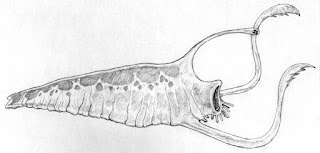Concepting
One interesting thing that often happens to me as a concept artist is the way an idea turns into drawings and then how those drawings start to evolve. One drawing suggests a redrawing and redefining of the visual narrative. That is, as you finish one drawing, that process would suggest another drawing, which in turn would suggest another drawing, and so on. As you’re drawing you’re also thinking about the whys and wherefores of the subject at hand. So, if the subject is some sort of creature, the ‘where it lives’, ‘how it lives’ etc stuff mentioned above shapes what you put down on paper. As that happens (and if you’re really trying to conceptualise the subject matter along as many ‘what ifs’ that you feel are worth the chase) the design branches off into various areas. In effect, you start to dissect the original idea in order to flesh out the concept, which in turn reinforces (or helps to refine and improve) that original idea. If you have an idea for a creature, it’s possible via drawing and thinking to start to go off along those design branches. You start thinking about how it moves, what it does when eating, fighting, etc. You can even start to think about what it’s made up of – internal organs, eyes, mouth, teeth, limbs, muscles, etc. This is all fine if it still revolves around the core of suggestions given by the original idea. This sort of thing translates well into a thought experiment. In my previous post, I noted the salient details about the Otyugh and then quibbled about what the text description said versus the illustration that went with it. The former suggests something somewhat different than the latter.
Themes
Most monsters, in some way or another, tend to share similar forms to actual creatures that exist in nature. Even the weird things dreamt up by H. P. Lovecraft were borne partly from his apparent phobia of fish. Similarly, a monster you’re designing can be partly based on what you personally find disgusting, unsettling, unsightly, etc. Thinking about where it might live, what it might eat, etc may also be derived from that. With the Otyugh, I tend to find that this ‘icky’ factor comes into play. First and foremost, its food is various repellent things, and it also lives in such stuff. It buries itself in it, leaving only its eyes above keeping watch. How it would do this if had legs, I’m not sure. As it can be a size L monster, I doubt that it can bury itself in dungeon waste if it’s above a certain height. I mean, as far as I’m aware dungeons – even really unkempt ones – don’t have passages that are (human) neck high in crap. With that in mind, what if the Otyugh is a fairly big monster that’s long and wide, rather than tall? What if it’s more like some sort of slug, or at least as malleable as one? We know that it has a pair of tentacles, two eyes on a stalk, and a sucker-like mouth. When combining those ideas with a slug-like form, I came up with this thumbnail sketch:

After a bit more scribbling, I came up with something a little more distinct:

This still didn’t zero in on the mental picture I have. I was imagining something more chunky and slug-like, rather than being a creature which is more like a ray or something like that. Mind you, it is perhaps more like an
Onch and to a certain extent has a similar way of existing (albeit in a different environment). I also started to think about some of the distinct parts of the Otyugh’s physiology, hence the pencil scribble of its ‘eyes’. With that, I was thinking that these are a quite simple eye – or appear to be. Perhaps the Otyugh’s aversion to light stems from the way its eyes work.
As all this was going on, the design was starting to take more of a distinct shape in my mind. Like I said before, ideas tend to develop as you’re drawing. For example, not only is the Otyugh like an onch, it also reminds me of a lamprey (because of its mouth and teeth), and a pig (because of the way I imagine it snuffling through the stuff it eats). The tentacles and eye stalk are similar in overall look and feel, i.e. stretchy pseudopod-like extensions. The fact that the tentacles have sharp ridges and the mouth has many teeth then made me start to wonder whether the Otyugh is made up of two ‘themes’ – rubbery, stretchy flesh and tougher, chitinous (or possibly mineral) areas that have some other function (i.e. eyes, armour, weapons). These themes partly borrow from sea creatures, but also tap into the slug/pig idea. This then led to another scribble:

One other idea that came into play was the way that the Otyugh perhaps might have semi-transparent areas, or is pretty much see-through all over but has opaque patches. If we think back to what I mentioned previously about the 'icky' factor, one thing I don't like about slugs is the fact that they can appear semi-transparent. Perhaps the Otyugh is also like this - it's a big rubbery, slug-like mass in which you can almost see its internal organs, etc. Note also with the above picture that I've included some scribbles about how the mouth might be formed. There's also a 'stretched flat' Otyugh (maybe it can get under some doors, just as slugs seem wont to do). The smallest thumbnail (bottom left) revolves around another question: what if the Otyugh can 'retract' it's tentacles...?























